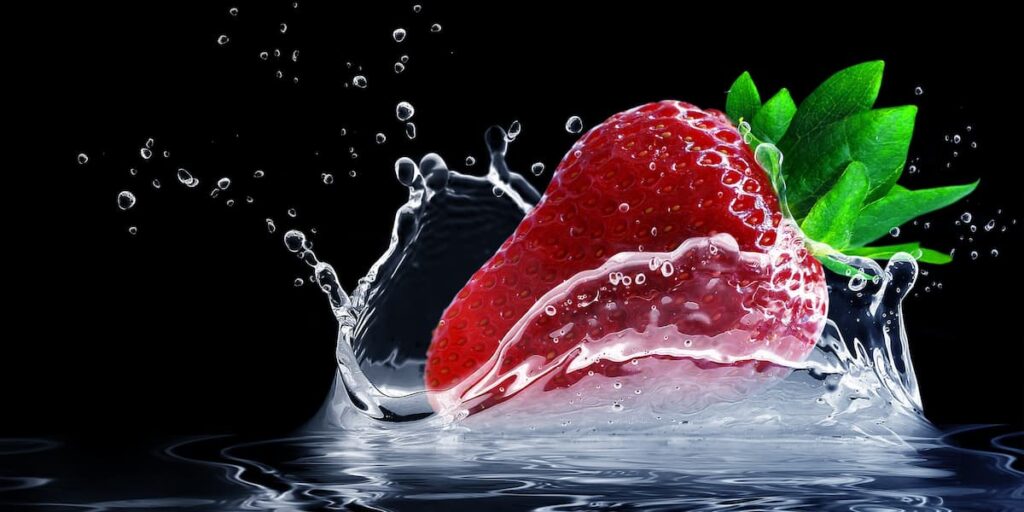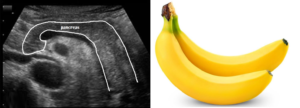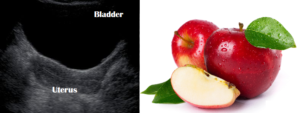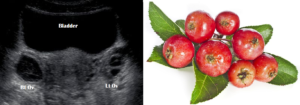
Sarah McCabe, BCIT Diagnostic Medical Sonography student, talks about ultrasound structures.
Ultrasound to fruit? You might be asking yourself what the connection is there. Let me clear it up—you’ve probably seen those charts that say what size your baby is based on how far along the mother is. For example, week five they are the size of a sesame seed, seven weeks a blueberry, 11 weeks a fig, 20 weeks a banana, 38 weeks a pumpkin, and so on.
I thought I would use this idea to compare sizes of different structures in our body to fruits. When I perform an ultrasound everything is magnified on the computer screen. Because we can zoom in or out on a structure it makes it difficult to know how big they are. We can measure the structures using the machine and it is pretty accurate to the actual size. I thought comparing it to fruit will make it easier to put it in perspective, because my eyes believe everything on the screen is to scale.
Everyone has different size structures, therefore these are approximations. Most of my comparisons with the fruit are in length—excluding the liver which is compared by weight.
The Heart—Dragonfruit
The heart pumps out 70-80 ml of blood in each beat. The average blood pressure is 120 over 80 with a heart rate of 60-100 beats per minute. It is about 12 cm long and 6 cm wide.

The Aorta—Cranberry
The aorta is part of the systemic circulation—it is one of the Great Vessels. It is important and works very hard because it takes nutrients and oxygenated blood from our heart and distributes it to the rest of our body. It is only 2-2.5 cm in diameter, and is nearest to the heart.

Are you a BCIT News insider? Sign-up to receive the latest news on BCIT.
The Pancreas—Banana
The pancreas is important for digesting carbohydrates, fats and proteins by releasing enzymes into the intestines to break them down. It is also important in maintaining glucose levels by releasing hormones into the blood. The pancreas is about 15 cm long. I can tell you when I first saw the pancreas, I was very surprised how big and long it was.

The Liver—Cantaloupe
The liver is very large on an ultrasound, you cannot miss it. It has many functions, I will simplify it slightly. The liver is responsible for metabolic regulation, blood processing, and bile production. Everyone has a different size liver. We do not normally measure the length of the liver because it is variable from person to person but it weighs approximately 1.5 kg.

The Gallbladder—Lemon
The gallbladder stores bile until it is needed. When you eat a fatty meal, the gallbladder releases bile to help break down the fat. It can hold 50 ml of bile. It is about 7-10 cm long.

The Kidneys—Mango
Most people know the kidneys make and remove urine but it also monitors blood volume and oxygen levels. The kidneys are 8-13 cm long. This fruit comparison has my favourite fruit, the mango.

Honorary Mention—The Spleen
What does the spleen do? No one really pays attention to the spleen, I almost forgot to add it—that’s why I made it an honorary mention. The spleen helps fight against infections, filters blood and makes red blood cells in the fetus. You can live without a spleen. Other organs such as the liver and lymph nodes can do the same function. I was shocked that it is the same size as the kidney. You have two mango sized organs on your left side.

The Uterus—Apple
It surprised me how small it actually is. Especially since it is the home of a baby, which means that the uterus has to grow a lot to accommodate for its tenant. The uterus is 7-8 cm long.

The Ovaries—Crab apple
The ovaries hold all the eggs we will ever have, about 2 million eggs. They make us crabby because they are hard to find on an Ultrasound, and crabby because of the hormones they release. They can be up to 4 cm long. That is about half the size of the uterus.

Learn more about the Diagnostic Medical Sonography program at BCIT.